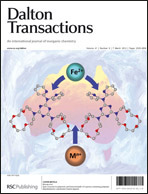The crystal structures and magnetic properties were investigated experimentally and theoretically for two S = ½ spin chain complexes, which consist of [M(mnt)2]− (M = Pt for 1 or Pd for 2) with 1-(4′-bromo-2′-flurobenzyl)-4-aminopyridinium (1-BrFBz-4-NH2Py+). The 1-BrFBz-4-NH2Py+ cations exhibit different molecular conformations and arrangements in 1 and 2; the [M(mnt)2]− anions form regular stacks in 1, whereas they form irregular stacks in 2. In addition, the intermolecular interactions between the [M(mnt)2]− anions and cations are also different from each other in the crystals of 1 and 2. Complex 1 shows the magnetic characteristics of a low-dimensional antiferromagnetic coupling spin system with a spin-Peierls-type transition around 7 K, and complex 2 exhibits diamagnetism over the temperature range of 5–300 K. Theoretical analyses, based on the calculations for the charge density distributions of [Pt(mnt)2]− and [Pd(mnt)2]− anions and the magnetic exchange constants within the anion spin chains, addressed the diverse molecular alignments in the crystals of 1 and 2 and distinct magnetic behaviors between 1 and 2.

You have access to this article
 Please wait while we load your content...
Something went wrong. Try again?
Please wait while we load your content...
Something went wrong. Try again?


 Please wait while we load your content...
Please wait while we load your content...